The Delimitation of Urban Growth Boundaries Using the CLUE-S Land-Use Change Model: Study on Xinzhuang Town, Changshu City, China
Abstract
:1. Introduction
2. Study Area and Methods
2.1. Study Area
2.2. Data Collection and Processing
2.2.1. Data Collection
2.2.2. Data Processing
2.3. The Settings of the CLUE-S Model
2.3.1. Spatial Policies and Restrictions
2.3.2. Land-Use Requirements (Demand)
- (i, j = 0, 1, 2, …, n) (the sum of the elements in each row equals one);
- 0 ≤ Pij ≤ 1 (i, j = 0, 1, 2, …, n) (all matrix members are non-negative and range between 0 and 1).
2.3.3. Location Characteristics
2.3.4. Land-Use Type-Specific Conversion Settings
2.4. Land-Use Change and Urban Growth Simulation
2.5. Simulation Accuracy Assessment of CLUE-S Model
2.6. The Delimitation of UGBs
3. Results
3.1. Simulation Accuracy Assessment
3.2. Land-Use Change and Urban Growth Prediction under Different Scenarios
3.3. The Delimitation of UGBs
4. Discussion
4.1. On the Suitability of CLUE-S Model in Delimitation of UGBs
4.2. Limitation of This Study
5. Conclusions
Acknowledgments
Author Contributions
Conflicts of Interest
References
- Long, Y.; Han, H.; Lai, S.; Mao, Q. Urban growth boundaries of the Beijing Metropolitan Area: Comparison of simulation and artwork. Cities 2013, 31, 337–348. [Google Scholar] [CrossRef]
- Erik, L.; Ding, C. Land use efficiency, food security, and farmland preservation in China. Land Lines 2006, 18, 2–7. [Google Scholar]
- Clover, J.; Eriksen, S. The effects of land tenure change on sustainability: Human security and environmental change in southern African savannas. Environ. Sci. Policy 2009, 12, 53–70. [Google Scholar] [CrossRef]
- Nelson, A.; Duncan, J. Growth Management Principles and Practices; American Planning Association Planners Press: Chicago, IL, USA, 1995. [Google Scholar]
- Long, Y.; Shen, Z.; Mao, Q. An urban containment planning support system for Beijing. Comput. Environ. Urban. 2011, 35, 297–307. [Google Scholar] [CrossRef]
- Pendall, R.; Martin, J.; Fulton, W. Holding the Line: Urban Containment in the United States; The Brookings Institution Center on Urban and Metropolitan Policy: Washington, DC, USA, 2002. [Google Scholar]
- Gordon, D.; Vipond, S. Gross density and new urbanism. J. Am. Plann. Assoc. 2005, 71, 41–54. [Google Scholar] [CrossRef]
- Bengston, D.; Youn, Y. Urban containment policies and the protection of natural area: The case of Seoul’s greenbelt. Ecol. Soc. 2006, 11, 3–13. [Google Scholar] [CrossRef]
- Coiacetto, E. Residential sub-market targeting by developers in Brisbane. Urban Policy Res. 2007, 25, 257–274. [Google Scholar] [CrossRef]
- Gunn, S. Green belts: A review of the region’s responses to a changing housing Agenda. J. Environ. Plan. Manag. 2007, 50, 595–616. [Google Scholar] [CrossRef]
- Fang, L. Study on American urban growth management policy and its reference to China. Chin. J. Land 1999, 8, 42–43. (In Chinese) [Google Scholar]
- Wu, Q.; Zhing, S. Review of Urban Growth Boundary research and analysis of its Sinicization. Trop Geol. 2011, 31, 409–415. [Google Scholar]
- Han, H.; Lai, S.; Dang, A.; Tan, Z.; Wu, C. Effectiveness of urban construction boundaries in Beijing: An assessment. J. Zhejiang. Univ-Sci. A 2009, 10, 1285–1295. [Google Scholar] [CrossRef]
- Tian, L.; Lv, C.; Shen, T. Theoretical and empirical research on implementation evaluation of city master plan: A case of Guangzhou City Master Plan (2001–2010). Urban Plan. Forum 2008, 5, 90–96. (In Chinese) [Google Scholar]
- Xu, Y.; Shi, S.; Fan, Y. Methodology of Shanghai City Master Planning in new position. Urban Plan. Forum 2009, 2, 10–15. (In Chinese) [Google Scholar]
- Ojima, D.; Lavorel, S.; Graumlich, L.; Moran, E. Terrestrial human-environment systems: The future of land research in IGBP II. IGBP. Glob. Chang. Newsl. 2002, 50, 31–34. [Google Scholar]
- Zhao, R.; Chen, Y.; Shi, P.; Zhang, L.; Pan, J.; Zhao, H. Land use and land cover change and driving mechanism in the arid inland river basin: A case study of Tarim River, Xinjiang, China. Environ. Earth. Sci. 2013, 68, 591–604. [Google Scholar] [CrossRef]
- Braimoh, A.; Onishi, T. Spatial determinants of urban land use change in Lagos, Nigeria. Land Use Policy 2007, 24, 502–515. [Google Scholar] [CrossRef]
- Luo, G.; Yin, C.; Chen, X.; Xu, W.; Lu, L. Combining system dynamic model and CLUE-S model to improve land use scenario analyses at regional scale: A case study of Sangong watershed in Xinjiang, China. Ecol. Complex. 2010, 7, 198–207. [Google Scholar] [CrossRef]
- Verburg, P.; Veldkamp, A. Projecting land use transitions at forest fringes in the Philippines at two spatial scales. Landsc. Ecol. 2004, 19, 77–98. [Google Scholar] [CrossRef]
- Houet, T.; Marchadier, C.; Bretagne, G.; Moine, M.; Aguejdad, R. Combining narratives and modeling approaches to simulate fine scale and long-term urban growth scenarios for climate adaptation. Environ. Model. Softw. 2016, 86, 1–13. [Google Scholar] [CrossRef]
- Vilet, J.; Bregt, A.; Brown, D.; Delden, H.; Heckbert, S. A review of current calibration and validation practices in land-change modeling. Environ. Model. Softw. 2016, 82, 174–182. [Google Scholar]
- Erik, K.; Piet, R.; Ton, D. Modeling land-use change for spatial planning support. Ann. Reg. Sci. 2008, 42, 1–10. [Google Scholar]
- Overmars, K.; Verburg, P.; Veldkamp, T. Comparison of a deductive and an inductive approach to specify land suitability in a spatially explicit land use model. Land Use Policy 2007, 24, 584–599. [Google Scholar] [CrossRef]
- Pan, Y.; Roth, A.; Yu, Z.; Doluschitz, R. The impact of variation in scale on the behavior of a cellular automata used for land use change modeling. Comput. Environ. Urban Syst. 2010, 34, 400–408. [Google Scholar] [CrossRef]
- Guan, D.; Li, H.; Inohae, T.; Su, W.; Nagaie, T.; Hokao, K. Modeling urban land use change by the integration of cellular automaton and Markov model. Ecol. Model. 2011, 222, 3761–3772. [Google Scholar] [CrossRef]
- Verburg, P.; Eickhout, B.; Meijl, H. A multi-scale, multi-model approach for analyzing the future dynamics of European land use. Ann. Reg. Sci. 2008, 42, 57–77. [Google Scholar] [CrossRef]
- Verburg, P.; Soepboer, W.; Limpiada, R. Land use change modeling at the regional scale: The CLUE-S model. Environ. Manag. 2002, 3, 391–405. [Google Scholar] [CrossRef] [PubMed]
- Verburg, P.; Overmars, K. Dynamic simulation of land use change trajectories with the CLUE model. Model. Land-Use Chang. 2007, 90, 321–335. [Google Scholar]
- Parker, D.; Manson, S.; Janssen, M.; Hoffmann, M.; Deadman, P. Multi-agent systems for the simulation of land use and land cover change: A review. Ann. Assoc. Am. Geogr. 2003, 93, 316–340. [Google Scholar] [CrossRef]
- Berger, T.; Schreinemachers, P.; Woelcke, J. Multi-agent simulation for the targeting of development policies in less-favored areas. Agric. Syst. 2006, 88, 28–43. [Google Scholar] [CrossRef]
- Zhou, R.; Su, H.; Hu, Y.; Li, Y.; Liu, M. Scenarios simulation of town land use change under different spatial constraints. Trans. CSAE 2011, 27, 300–308. (In Chinese) [Google Scholar]
- Veldkamp, A.; Fresco, L. CLUE: A conceptual model to study the conversion of land use and its effects. Ecol. Model. 1996, 2, 253–270. [Google Scholar] [CrossRef]
- Verburg, P.; Veldkamp, A.; Bouma, J. Land-use change under conditions of high population pressure: The case of Java. Glob. Environ. Chang. 1999, 9, 303–312. [Google Scholar] [CrossRef]
- Muller, M.; Middleton, J. A Markov model of land-use change dynamics in the Niagara Region, Ontario, Canada. Landsc. Ecol. 1994, 9, 151–157. [Google Scholar]
- Reveshty, M. The assessment and predicting of land use changes to urban area using multi-temporal satellite imagery and GIS: A case study on Zanjan, IRAN (1984–2011). J. Geogr. Inf. Syst. 2011, 3, 298–305. [Google Scholar] [CrossRef]
- Xia, H.; Liu, H.; Zheng, C. A Markov-Kalman model of land-use change prediction in XiuHe Basin, China. In Geo-Informatics in Resource Management and Sustainable Ecosystem; Springer: Berlin/Heidelberg, Germany, 2013; pp. 75–85. [Google Scholar]
- Yang, X.; Zheng, X.; Chen, R. A land use change model: Integrating landscape pattern indexes and Markov-CA. Ecol. Model. 2014, 282, 1–7. [Google Scholar] [CrossRef]
- Zheng, H.; Shen, G.; Wang, H.; Hong, J. Simulating land use change in urban renewal areas: A case study in Hong Kong. Habitat. Int. 2015, 43, 23–34. [Google Scholar] [CrossRef]
- Bucini, G.; Lambin, E. Fire impacts on vegetation in Central Africa: A remote-sensing based statistical analysis. Appl. Geogr. 2002, 22, 27–48. [Google Scholar] [CrossRef]
- Pontius, R.; Schneider, L. Land-cover change model validation by an ROC method for the Ipswich watershed, Massachusetts, USA. Agric. Ecosyst. Environ. 2001, 85, 239–248. [Google Scholar] [CrossRef]
- Pontius, J. Quantification error versus location error in comparison of categorical maps. Photogram. Eng. Remote Sens. 2000, 8, 1011–1016. [Google Scholar]
- Veldkamp, A.; Verburg, P. Methodology for Simulating the Spatial Dynamics of Land Use Change in Forest Fringes. 2002. Available online: http://edepot.wur.nl/314616 (accessed on 15 November 2016).
- Zheng, X.; Zhao, L.; Xiang, W.; Li, N.; Lv, L.; Yang, X. A coupled model for simulating spatio-temporal dynamics of land-use change: A case study in Changqing, Jinan, China. Landsc. Urban. Plan. 2012, 106, 51–61. [Google Scholar] [CrossRef]
- R Development Core Team. R Version x64 3.3.1. Available online: https://cran.r-project.org/ (accessed on 20 June 2016).
- James, P.; Holden, M.; Lewin, M.; Neilson, L.; Oakley, C.; Truter, A.; Wilmoth, D. Managing Metropolises by Negotiating Mega-Urban Growth. Harald Mieg and Klaus Töpfer. In Institutional and Social Innovation for Sustainable Urban Development; Routledge: Oxford, UK, 2013. [Google Scholar]
- Wei, L. GIS Modeling of Urbanization Impacts on Natural Resources. Master’s Thesis, Iowa State University, Ames, IA, USA, 2007. [Google Scholar]
- Evans, A. Economics and Land Use Planning; John Wiley and Sons: Hoboken, NJ, USA, 2008. [Google Scholar]
- Lewis, P.G. Shaping Suburbia: How Political Institutions Organize Urban Development; University of Pittsburgh Press: Pittsburgh, PA, USA, 1996. [Google Scholar]
- Gao, Z. Analysis of Disorder in Land Use Planning. Planners 2000, 16, 57–59. (In Chinese) [Google Scholar]
- Li, Y. Method of determining urban growth boundary from the view of ecology: A case study of Hangzhou. City Plan. Rev. 2011, 35, 83–90. (In Chinese) [Google Scholar]
- Zhu, Z.; Mo, B.; Xie, F. Delimitation of urban growth boundary based on land ecological suitability evaluation: A case of Fangchenggang. Planners 2009, 25, 40–44. (In Chinese) [Google Scholar]
- Halmy, M.; Gessler, P.; Hicke, J.; Salem, B. Land use/land cover change detection and prediction in the north-western coastal desert of Egypt using Markov-CA. Appl. Geogr. 2015, 63, 101–112. [Google Scholar] [CrossRef]
- Han, Y.; Jia, H. Simulating the spatial dynamics of urban growth with an integrated modeling approach: A case study of Foshan, China. Ecol. Model. 2016, 10, 1–10. [Google Scholar]
- Mao, X.; Meng, J.; Wang, Q. Modeling the effects of tourism and land regulation on land-use change in tourist regions: A case study of the Lijiang River Basin in Guilin, China. Land Use Policy 2014, 41, 368–377. [Google Scholar] [CrossRef]
- Liu, M.; Hu, Y.; Chang, Y.; He, X.; Zhang, W. Land use and land cover change analysis and prediction in the upper reaches of the Minjiang River, China. Environ. Manag. 2009, 43, 899–907. [Google Scholar] [CrossRef] [PubMed]
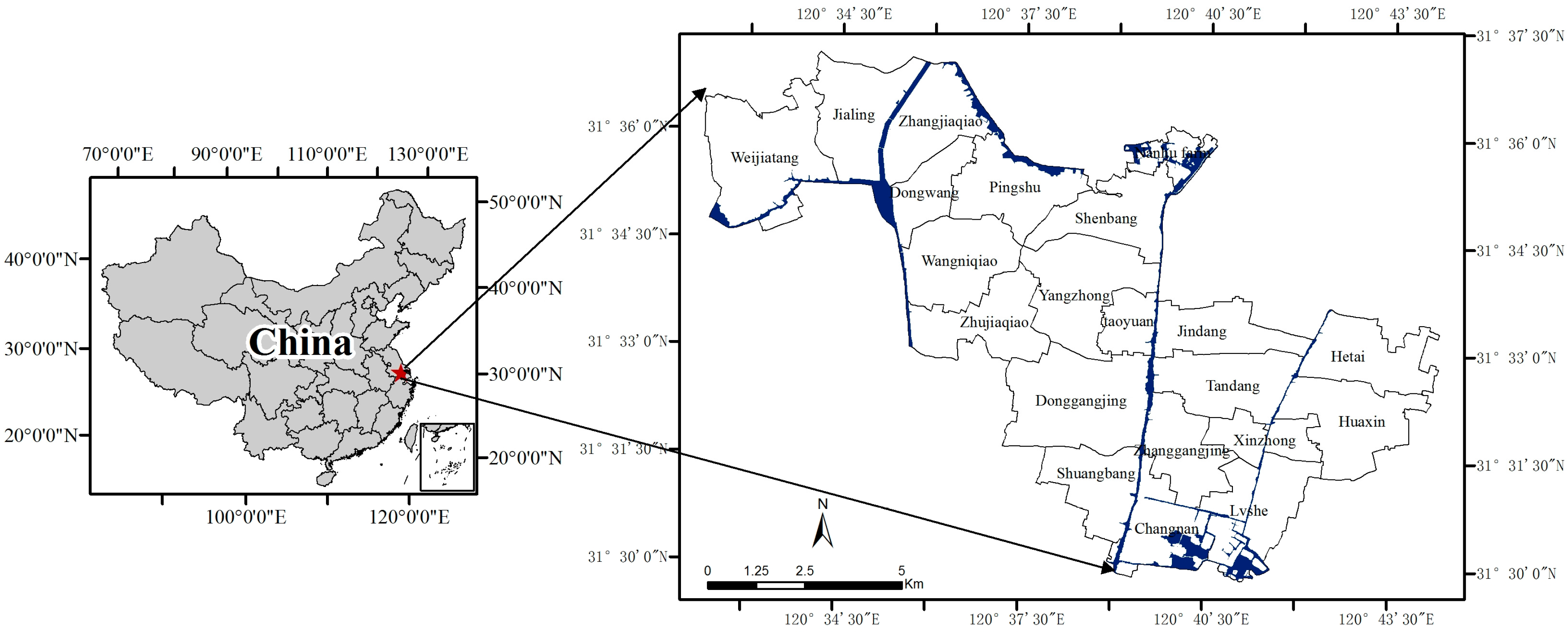

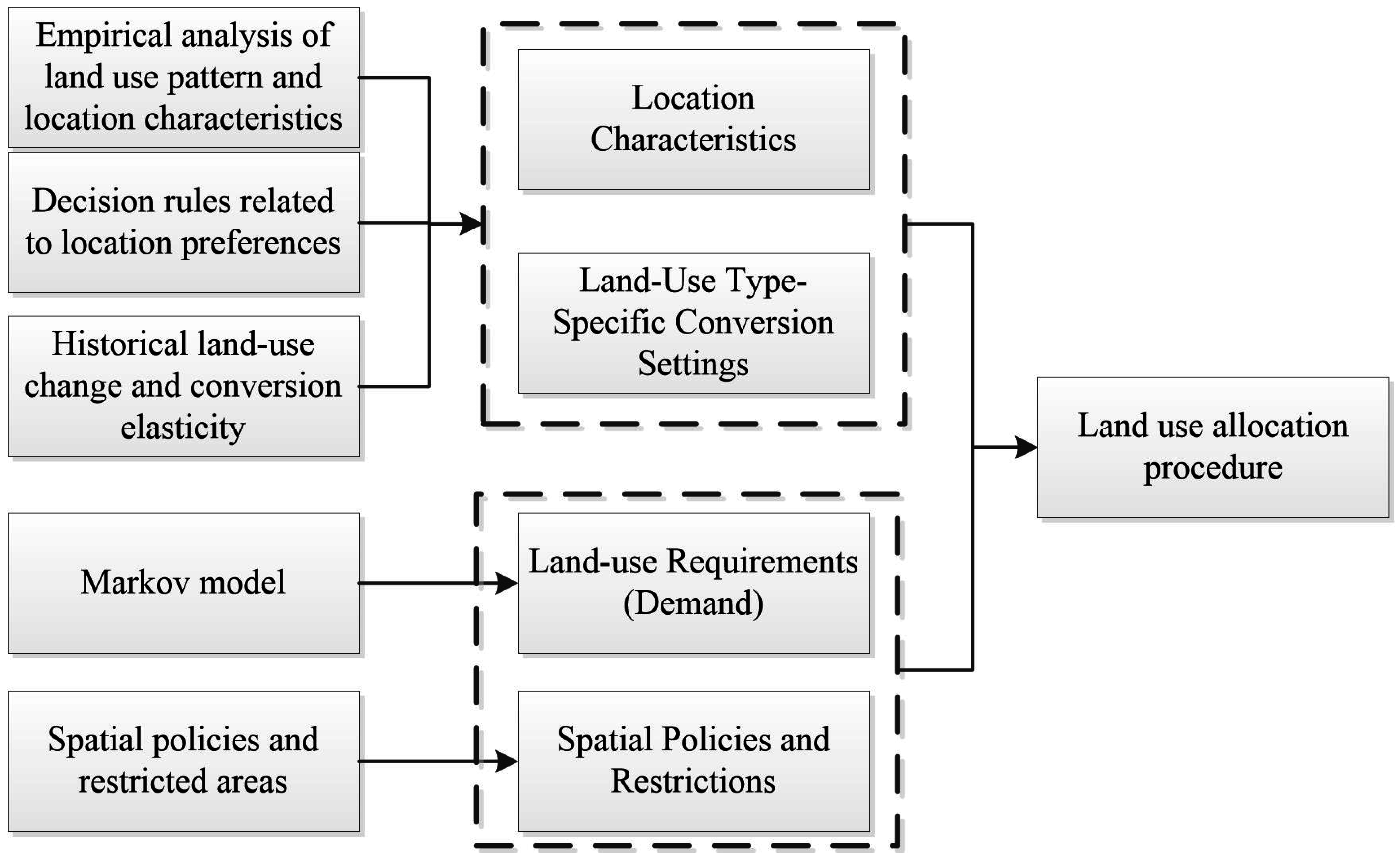
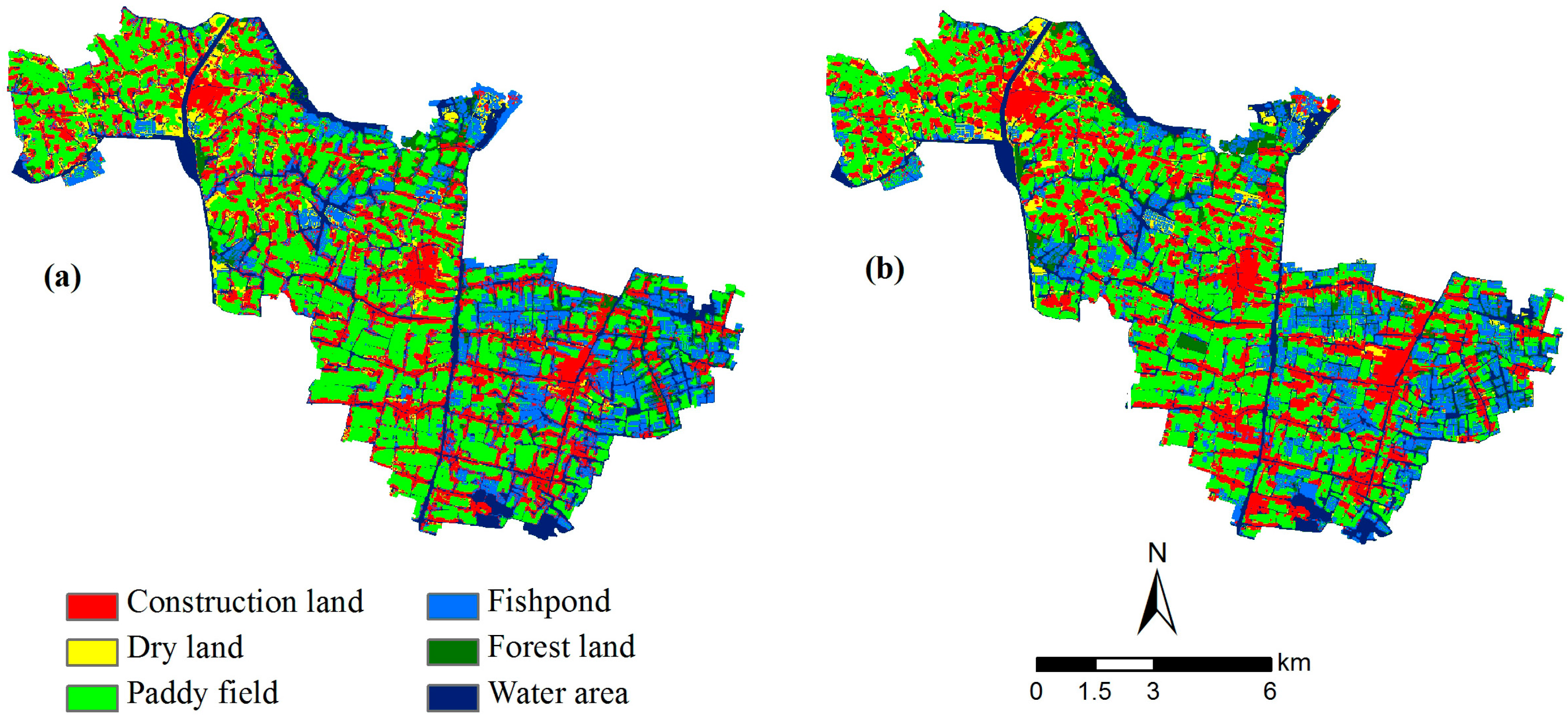
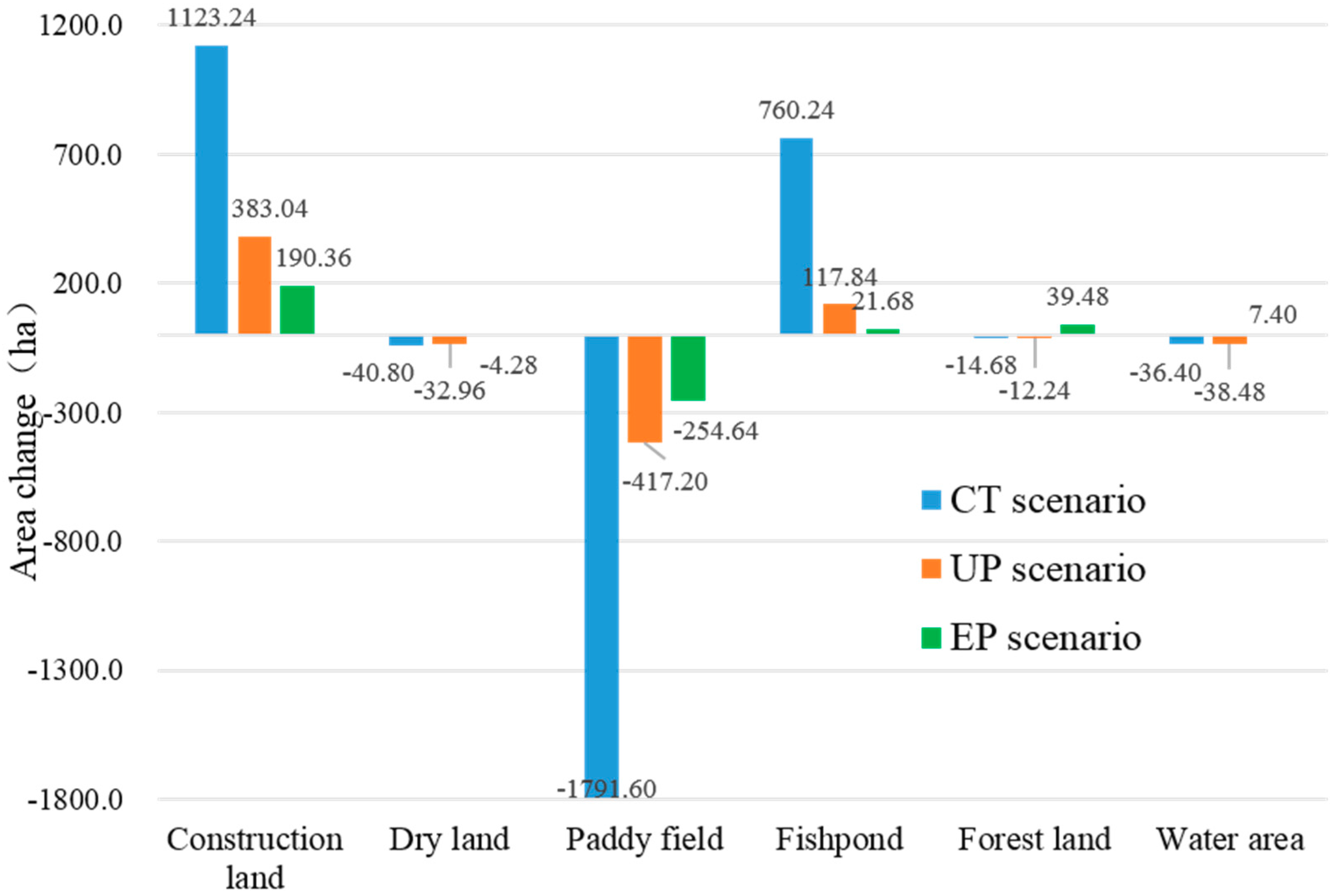
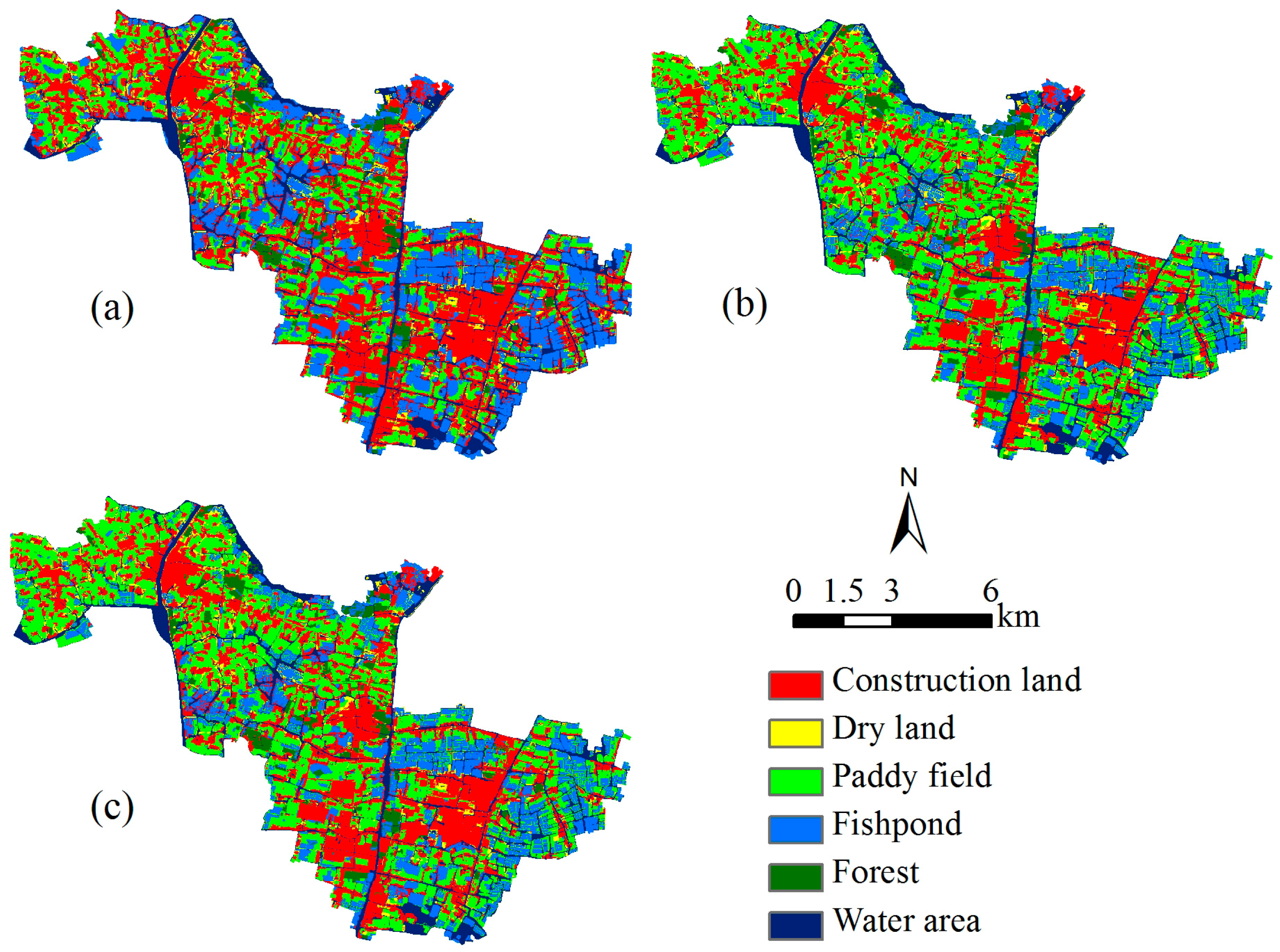
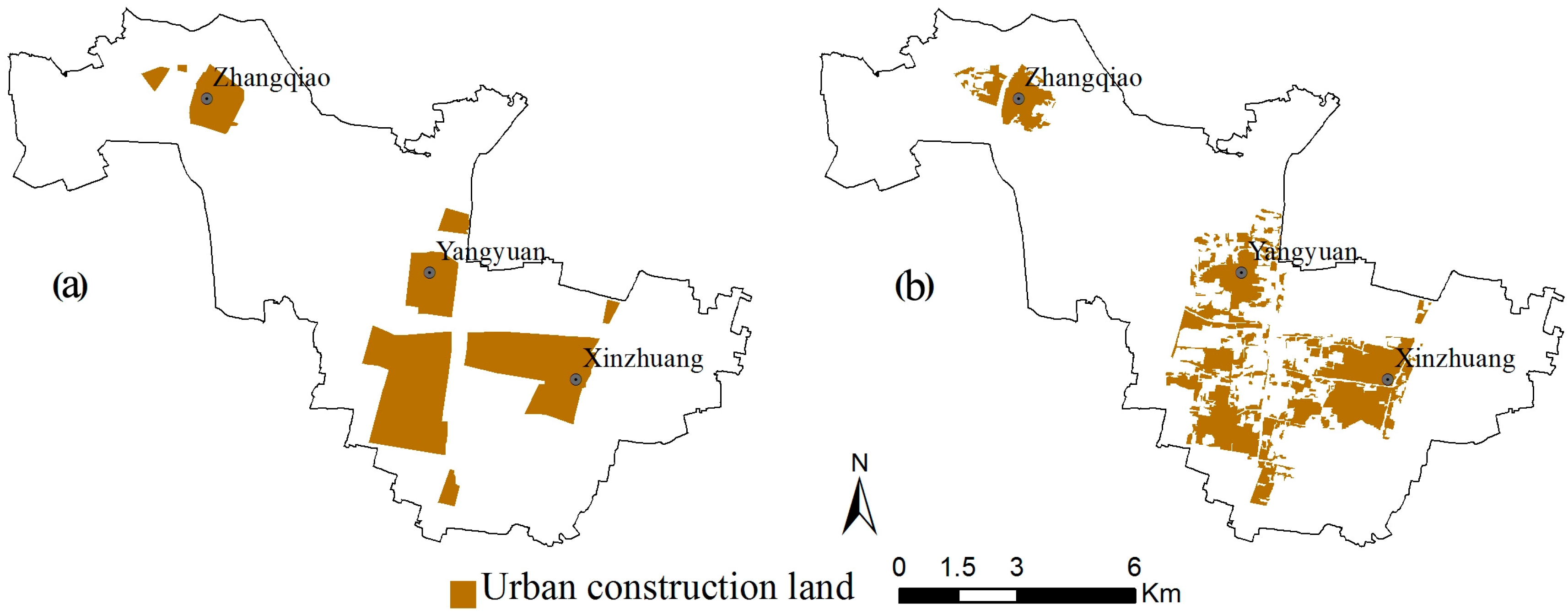
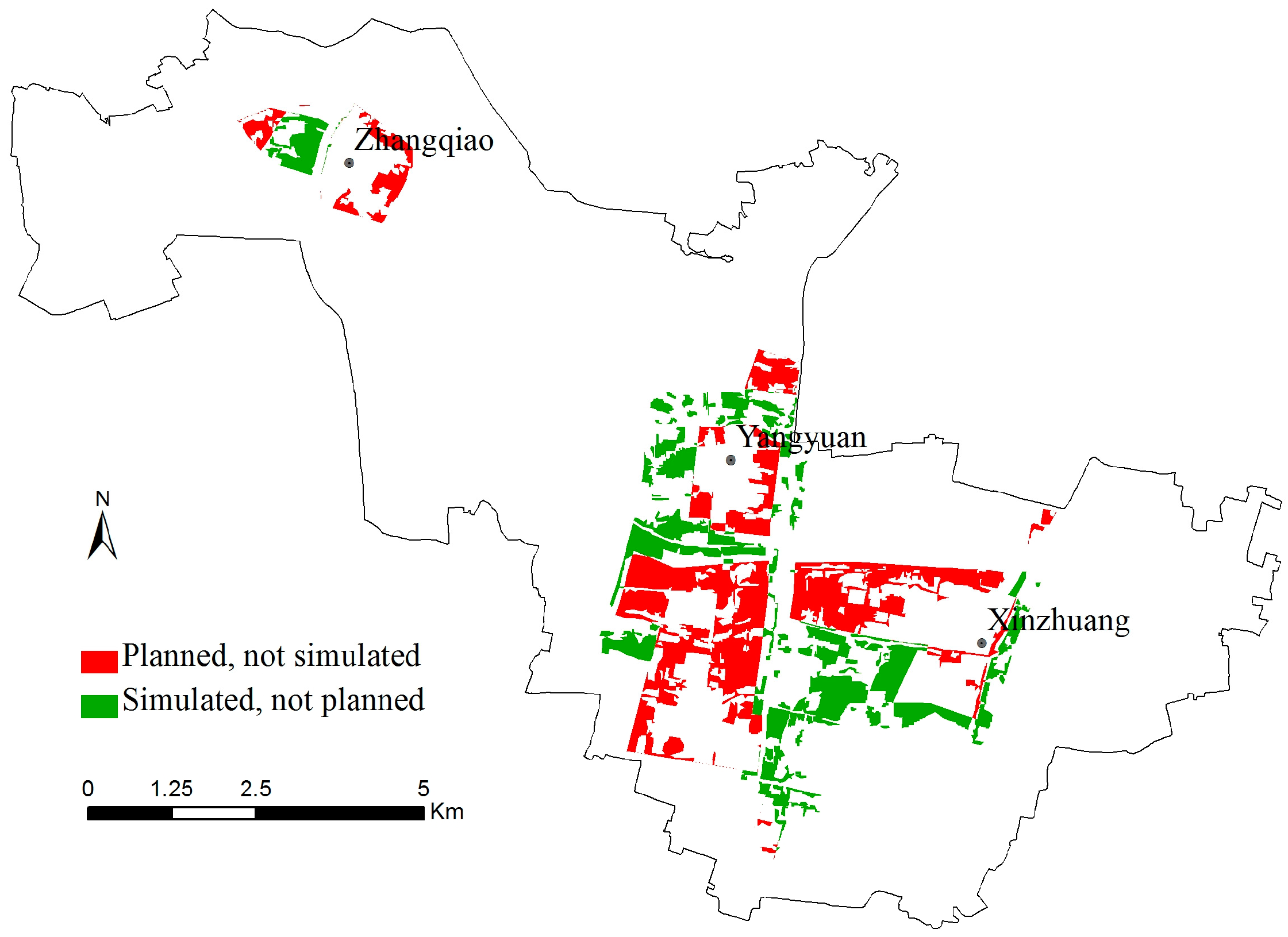
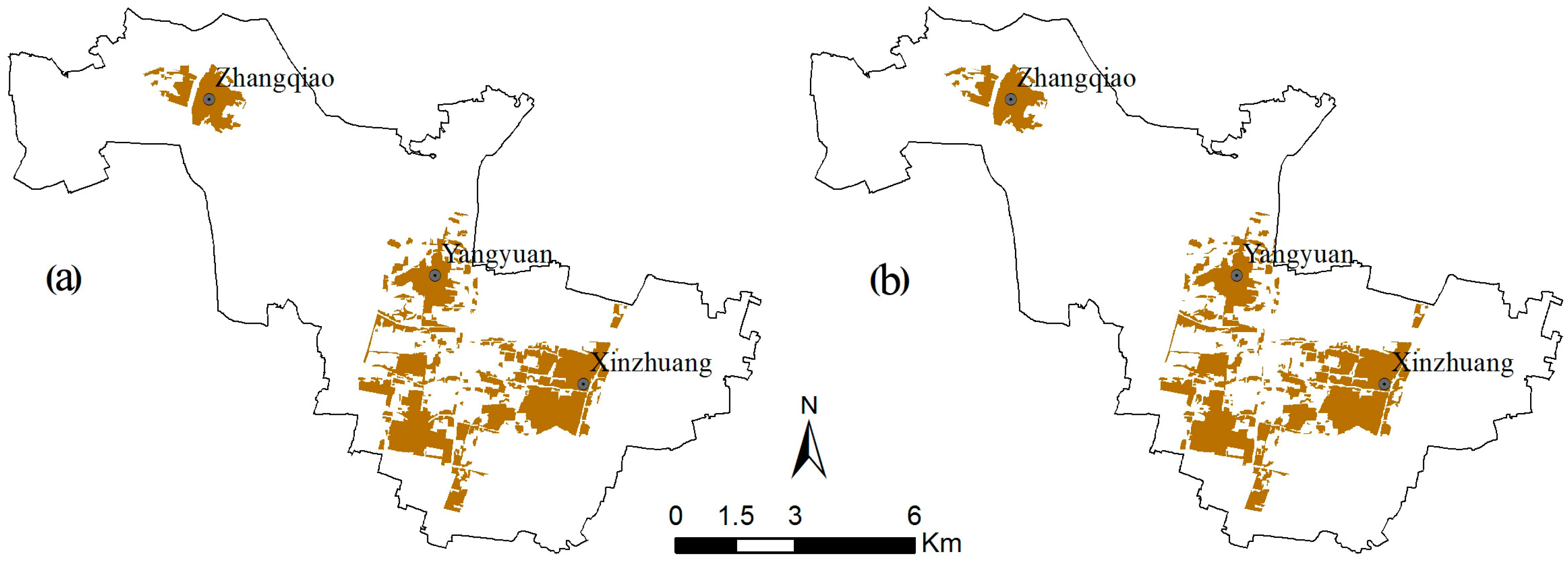
| Scenario | Construction Land | Dry Land | Paddy Field | Fishpond | Forest | Water | |
|---|---|---|---|---|---|---|---|
| 1991–2009 | 0.9 | 0.5 | 0.4 | 0.8 | 0.6 | 0.7 | |
| 2009–2027 | CT | 0.9 | 0.5 | 0.4 | 0.8 | 0.6 | 0.7 |
| UP | 0.9 | 0.7 | 0.6 | 0.8 | 0.6 | 0.7 | |
| EP | 0.9 | 0.6 | 0.4 | 0.8 | 0.8 | 0.8 |
| Land-Use Type | 1991 | 2001 | 2009 |
|---|---|---|---|
| Dry land | 0.711 | 0.706 | 0.759 |
| Construction land | 0.969 | 0.917 | 0.951 |
| Forest | 0.768 | 0.814 | 0.815 |
| Water area | 1.000 | 0.990 | 0.988 |
| Paddy field | 0.776 | 0.729 | 0.792 |
| Fishpond | 0.809 | 0.786 | 0.812 |
© 2016 by the authors; licensee MDPI, Basel, Switzerland. This article is an open access article distributed under the terms and conditions of the Creative Commons Attribution (CC-BY) license (http://creativecommons.org/licenses/by/4.0/).
Share and Cite
Zhou, R.; Zhang, H.; Ye, X.-Y.; Wang, X.-J.; Su, H.-L. The Delimitation of Urban Growth Boundaries Using the CLUE-S Land-Use Change Model: Study on Xinzhuang Town, Changshu City, China. Sustainability 2016, 8, 1182. https://doi.org/10.3390/su8111182
Zhou R, Zhang H, Ye X-Y, Wang X-J, Su H-L. The Delimitation of Urban Growth Boundaries Using the CLUE-S Land-Use Change Model: Study on Xinzhuang Town, Changshu City, China. Sustainability. 2016; 8(11):1182. https://doi.org/10.3390/su8111182
Chicago/Turabian StyleZhou, Rui, Hao Zhang, Xin-Yue Ye, Xin-Jun Wang, and Hai-Long Su. 2016. "The Delimitation of Urban Growth Boundaries Using the CLUE-S Land-Use Change Model: Study on Xinzhuang Town, Changshu City, China" Sustainability 8, no. 11: 1182. https://doi.org/10.3390/su8111182






